High-Resolution Modeling of Mesoscale Circulation in the Atmospheric Boundary Layer over a Complex Coastal Area
Abstract
:1. Introduction
2. Materials and Methods
2.1. Site Description and Observations
2.2. Model Description
2.3. Evaluation
2.4. Sea-Breeze Characteristics
- Onset (LST): The onset is the time when the sea-breeze front (SBF) passes. The time of SBF passage is defined as the time when the wind direction at 10 m AGL changes from offshore or weak wind (wind speed ≤ 1.5 m s−1) to onshore flow (60°–240°) after sunrise, and when the change in wind direction is greater than 30° over the course of an hour;
- Cessation (LST): The cessation is the time when the sea breeze ends. The cessation happens when the wind speed at 10 m AGL is ≤1.5 m s−1, or when the wind is an offshore flow between 15:00 and 24:00 LST. Before offshore flow, the previous wind must be blown onshore;
- Depth of sea breeze: The depth of onshore flow with a speed ≥1.5 m s−1;
- Intensity of sea breeze: The wind speed of the sea breeze.
- We calculate the sea-breeze characteristics by using 10-minute moving-average data for both simulation and observation.
2.5. Design of Sensitivity Experiment
3. Observations and Model Evaluation
3.1. General Meteorological Conditions for 15 July 2018
3.2. Model Evaluation
4. Analysis of Numerical Simulation and Discussion
4.1. Regional-Scale Description of the Flows
4.2. Down-Valley Wind and Sea Breeze at BSWO
4.3. Sensitivity of Simulated Flow Structure to Model Resolution
5. Summary
Author Contributions
Funding
Institutional Review Board Statement
Informed Consent Statement
Data Availability Statement
Acknowledgments
Conflicts of Interest
References
- Glickman, T.S. Glossary of Meteorology, 2nd ed.; American Meteorological Society: Boston, MA, USA, 2000; p. 855. [Google Scholar]
- Baklanov, A.A.; Grisogono, B.; Bornstein, R.; Mahrt, L.; Zilitinkevich, S.S.; Taylor, P.; Larsen, S.E.; Rotach, M.W.; Fernando, H.J.S. The Nature, Theory, and Modeling of Atmospheric Planetary Boundary Layers. Bull. Am. Meteorol. Soc. 2011, 92, 123–128. [Google Scholar] [CrossRef] [Green Version]
- LeMone, M.A.; Angevine, W.M.; Bretherton, C.S.; Chen, F.; Dudhia, J.; Fedorovich, E.; Katsaros, K.B.; Lenschow, D.H.; Mahrt, L.; Patton, E.G.; et al. 100 Years of Progress in Boundary Layer Meteorology. Meteorol. Monogr. 2019, 59, 9.1–9.85. [Google Scholar] [CrossRef]
- Steiner, M. Urban Air Mobility: Opportunities for the Weather Community. Bull. Am. Meteorol. Soc. 2019, 100, 2131–2133. [Google Scholar] [CrossRef]
- Haupt, S.E.; Rauber, R.M.; Carmichael, B.; Knievel, J.C.; Cogan, J.L. 100 Years of Progress in Applied Meteorology. Part I: Basic Applications. Meteorol. Monogr. 2018, 59, 22.1–22.33. [Google Scholar] [CrossRef]
- Stith, J.L.; Baumgardner, D.; Haggerty, J.; Hardesty, R.M.; Lee, W.-C.; Lenschow, D.; Pilewskie, P.; Smith, P.L.; Steiner, M.; Vömel, H. 100 Years of Progress in Atmospheric Observing Systems. Meteorol. Monogr. 2018, 59, 2.1–2.55. [Google Scholar] [CrossRef]
- Michener, W.K.; Blood, E.R.; Bildstein, I.K.L.; Brinson, M.M.; Gardner, L.R. Climate Change, Hurricanes and Tropical Storms, and Rising Sea Level in Coastal Wetlands. Ecol. Appl. 1997, 7, 770–801. [Google Scholar] [CrossRef]
- Bastin, S.; Drobinski, P. Sea-Breeze-Induced Mass Transport over Complex Terrain in South-Eastern France: A Case-Study. Q. J. R. Meteorol. Soc. 2006, 132, 405–423. [Google Scholar] [CrossRef] [Green Version]
- Pérez-Landa, G.; Ciais, P.; Sanz, M.J.; Gioli, B.; Miglietta, F.; Palau, J.L.; Gangoiti, G.; Millán, M.M. Mesoscale Circulations over Complex Terrain in the Valencia Coastal Region, Spain—Part 1: Simulation of Diurnal Circulation Regimes. Atmos. Chem. Phys. 2007, 7, 1835–1849. [Google Scholar] [CrossRef] [Green Version]
- Arrillaga, J.A.; Yagüe, C.; Sastre, M.; Román-Cascón, C. A Characterisation of Sea-Breeze Events in the Eastern Cantabrian Coast (Spain) from Observational Data and WRF Simulations. Atmos. Res. 2016, 181, 265–280. [Google Scholar] [CrossRef]
- Caicedo, V.; Rappenglueck, B.; Cuchiara, G.; Flynn, J.; Ferrare, R.; Scarino, A.J.; Berkoff, T.; Senff, C.; Langford, A.; Lefer, B. Bay Breeze and Sea Breeze Circulation Impacts on the Planetary Boundary Layer and Air Quality from an Observed and Modeled DISCOVER-AQ Texas Case Study. J. Geophys. Res. Atmos. 2019, 124, 7359–7378. [Google Scholar] [CrossRef]
- Ryu, Y.-H.; Baik, J.-J. Daytime Local Circulations and Their Interactions in the Seoul Metropolitan Area. J. Appl. Meteorol. Climatol. 2013, 52, 784–801. [Google Scholar] [CrossRef]
- Hughes, C.P.; Veron, D.E. A Characterization of the Delaware Sea Breeze Using Observations and Modeling. J. Appl. Meteorol. Climatol. 2018, 57, 1405–1421. [Google Scholar] [CrossRef]
- Lim, H.-J.; Lee, Y.-H. Characteristics of sea breezes at coastal area in Boseong. Atmosphere 2019, 29, 41–51. [Google Scholar] [CrossRef]
- Lee, Y.-H. Climatology of Nocturnal Low-Level Wind Maxima at a Topographically Complex Coastal Site in Boseong. Meteorol. Atmos. Phys. 2021, 133, 643–653. [Google Scholar] [CrossRef]
- Lee, Y.-H. Observational Analysis of Tidal Effect on Sea Breeze. Bound.-Layer Meteorol. 2021, 180, 273–288. [Google Scholar] [CrossRef]
- Korea Meteorological Administration. Application of Boseong Global Standard Observatory (I); NIMR-2014-B-11; Korea Meteorological Administration: Seoul, Korea, 2014; pp. 1–128.
- Skamarock, W.C.; Klemp, J.B. A Time-Split Nonhydrostatic Atmospheric Model for Weather Research and Forecasting Applications. J. Comput. Phys. 2008, 227, 3465–3485. [Google Scholar] [CrossRef]
- Hersbach, H.; Bell, B.; Berrisford, P.; Hirahara, S.; Horányi, A.; Muñoz-Sabater, J.; Nicolas, J.; Peubey, C.; Radu, R.; Schepers, D.; et al. The ERA5 Global Reanalysis. Q. J. R. Meteorol. Soc. 2020, 146, 1999–2049. [Google Scholar] [CrossRef]
- Farr, T.G.; Rosen, P.A.; Caro, E.; Crippen, R.; Duren, R.; Hensley, S.; Kobrick, M.; Paller, M.; Rodriguez, E.; Roth, L.; et al. The Shuttle Radar Topography Mission. Rev. Geophys. 2007, 45. [Google Scholar] [CrossRef] [Green Version]
- Lim, K.-S.S.; Hong, S.-Y. Development of an Effective Double-Moment Cloud Microphysics Scheme with Prognostic Cloud Condensation Nuclei (CCN) for Weather and Climate Models. Mon. Weather Rev. 2010, 138, 1587–1612. [Google Scholar] [CrossRef] [Green Version]
- Dudhia, J. Numerical Study of Convection Observed during the Winter Monsoon Experiment Using a Mesoscale Two-Dimensional Model. J. Atmos. Sci. 1989, 46, 3077–3107. [Google Scholar] [CrossRef]
- Mlawer, E.J.; Taubman, S.J.; Brown, P.D.; Iacono, M.J.; Clough, S.A. Radiative Transfer for Inhomogeneous Atmospheres: RRTM, a Validated Correlated-k Model for the Longwave. J. Geophys. Res. Atmos. 1997, 102, 16663–16682. [Google Scholar] [CrossRef] [Green Version]
- Kain, J.S. The Kain–Fritsch Convective Parameterization: An Update. J. Appl. Meteorol. 2004, 43, 170–181. [Google Scholar] [CrossRef] [Green Version]
- Tewari, M.; Chen, F.; Wang, W.; Dudhia, J.; Le Mone, M.; Mitchell, K.; Ek, M.; Gayno, G.; Wegiel, J.; Cuenca, R. Implementation and verification of the unified NOAH land surface model in the WRF model. In Proceedings of the 20th Conference on Weather Analysis and Forecasting/16th Conference on Numerical Weather Prediction, Seattle, WA, USA, 14–16 January 2004; American Meteorological Society: Seattle, WA, USA, 2004; Volume 1115, pp. 2165–2170. [Google Scholar]
- Jiménez, P.A.; Dudhia, J.; González-Rouco, J.F.; Navarro, J.; Montávez, J.P.; García-Bustamante, E. A Revised Scheme for the WRF Surface Layer Formulation. Mon. Weather Rev. 2012, 140, 898–918. [Google Scholar] [CrossRef] [Green Version]
- Wyngaard, J.C. Toward Numerical Modeling in the “Terra Incognita”. J. Atmos. Sci. 2004, 61, 11. [Google Scholar] [CrossRef]
- Shin, H.H.; Hong, S.-Y. Representation of the Subgrid-Scale Turbulent Transport in Convective Boundary Layers at Gray-Zone Resolutions. Mon. Weather Rev. 2015, 143, 250–271. [Google Scholar] [CrossRef]
- Willmott, C.J.; Ackleson, S.G.; Davis, R.E.; Feddema, J.J.; Klink, K.M.; Legates, D.R.; O’Donnell, J.; Rowe, C.M. Statistics for the Evaluation and Comparison of Models. J. Geophys. Res. Ocean. 1985, 90, 8995–9005. [Google Scholar] [CrossRef] [Green Version]
- Crosman, E.T.; Horel, J.D. Sea and Lake Breezes: A Review of Numerical Studies. Bound.-Layer Meteorol. 2010, 137. [Google Scholar] [CrossRef] [Green Version]
- Prtenjak, M.T.; Grisogono, B.; Nitis, T. Shallow Mesoscale Flows at the North-Eastern Adriatic Coast. Q. J. R. Meteorol. Soc. 2006, 132, 2191–2215. [Google Scholar] [CrossRef]
- Whiteman, C.D. Mountain Meteorology: Fundamentals and Applications; Oxford University Press: New York, NY, USA, 2000; p. 355. [Google Scholar]
- Lemonsu, A.; Bastin, S.; Masson, V.; Drobinski, P. Vertical Structure of the Urban Boundary Layer over Marseille Under Sea-Breeze Conditions. Bound.-Layer Meteorol. 2006, 118, 477–501. [Google Scholar] [CrossRef]
- Banta, R.M. Sea breezes shallow and deep on the California coast. Mon. Weather Rev. 1995, 123, 3614–3622. [Google Scholar] [CrossRef] [Green Version]
- Holton, J.R.; Hakim, G.J. An Introduction to Dynamic Meteorology, 5th ed.; Academic Press: Waltham, MA, USA, 2013; p. 532. [Google Scholar]
- Mahrt, L. Stratified Atmospheric Boundary Layers. Bound. Layer Meteorol. 1999, 90, 375–396. [Google Scholar] [CrossRef]
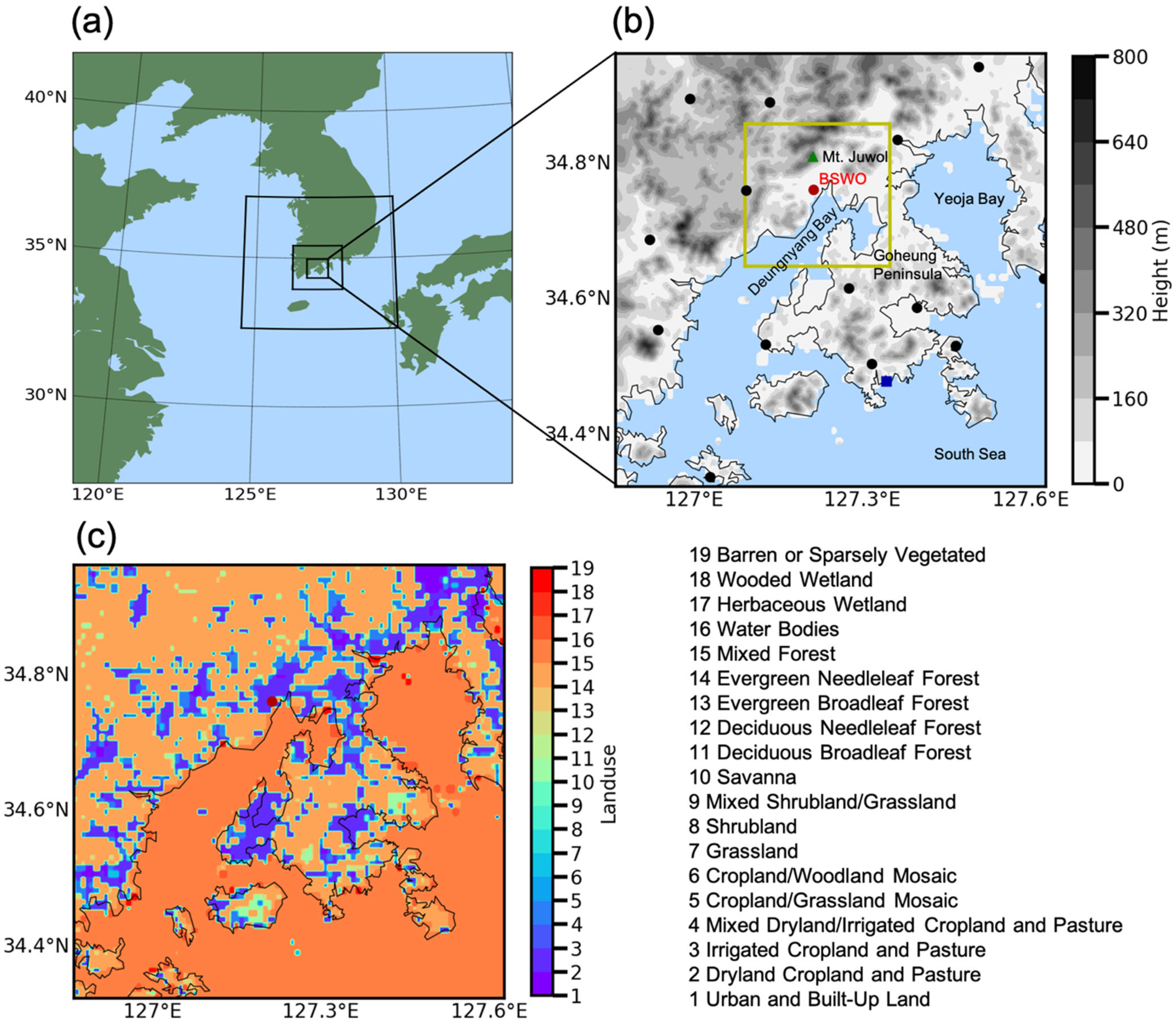
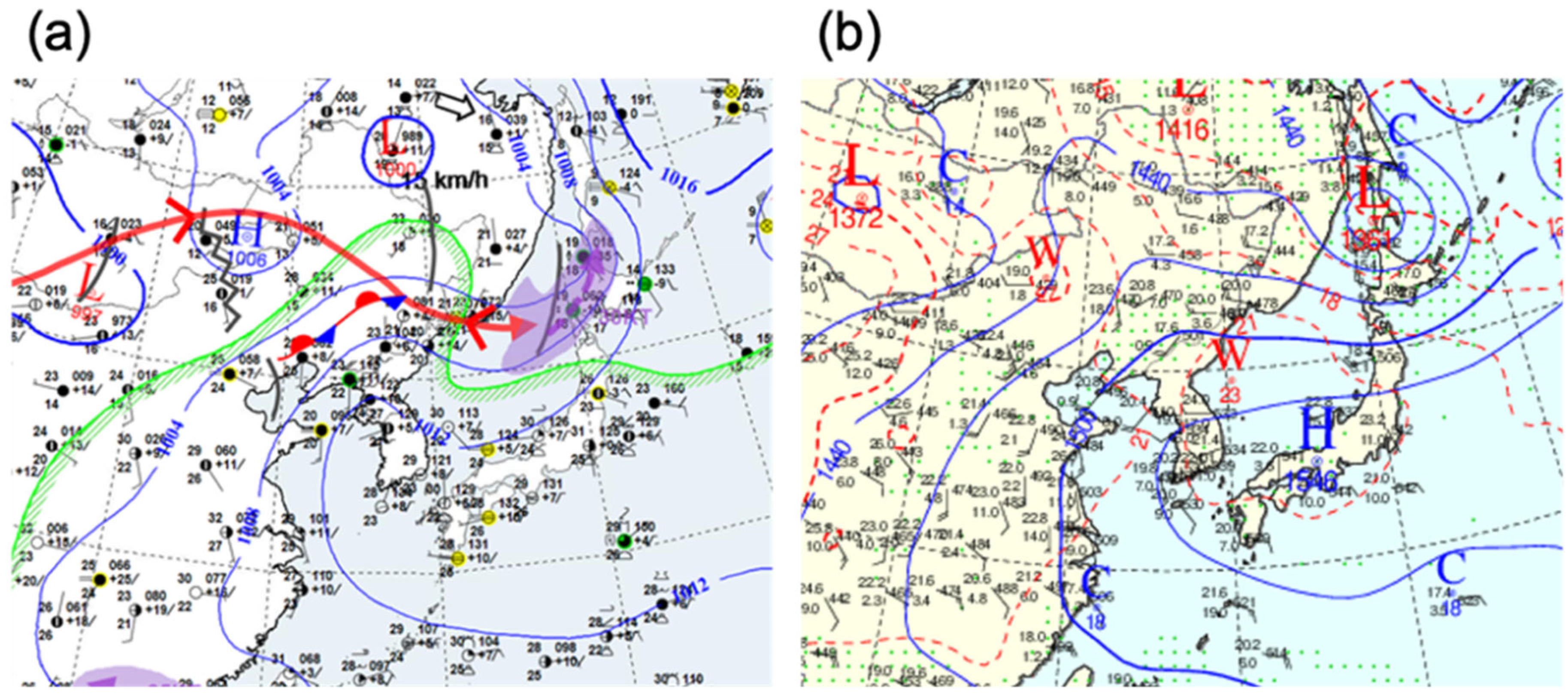
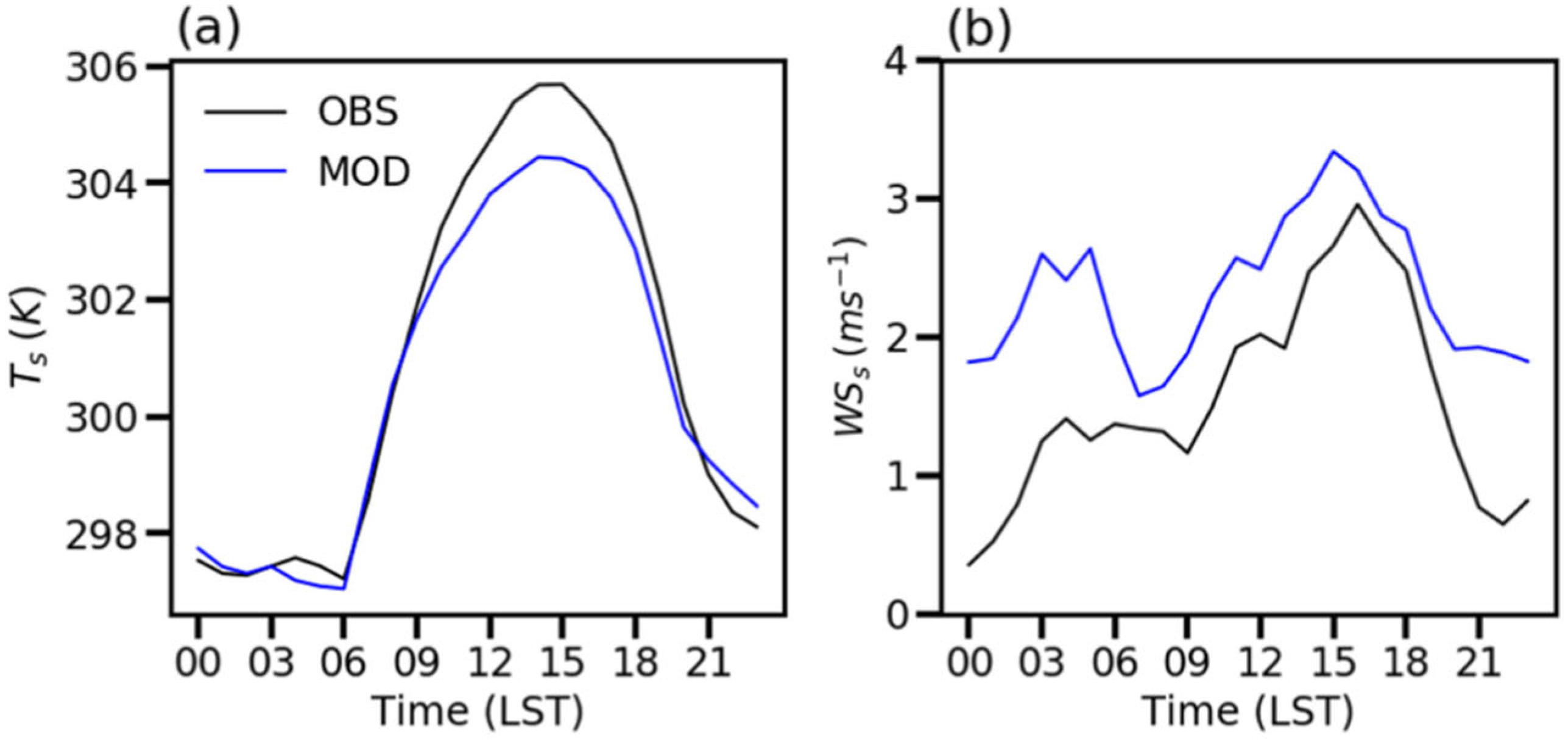
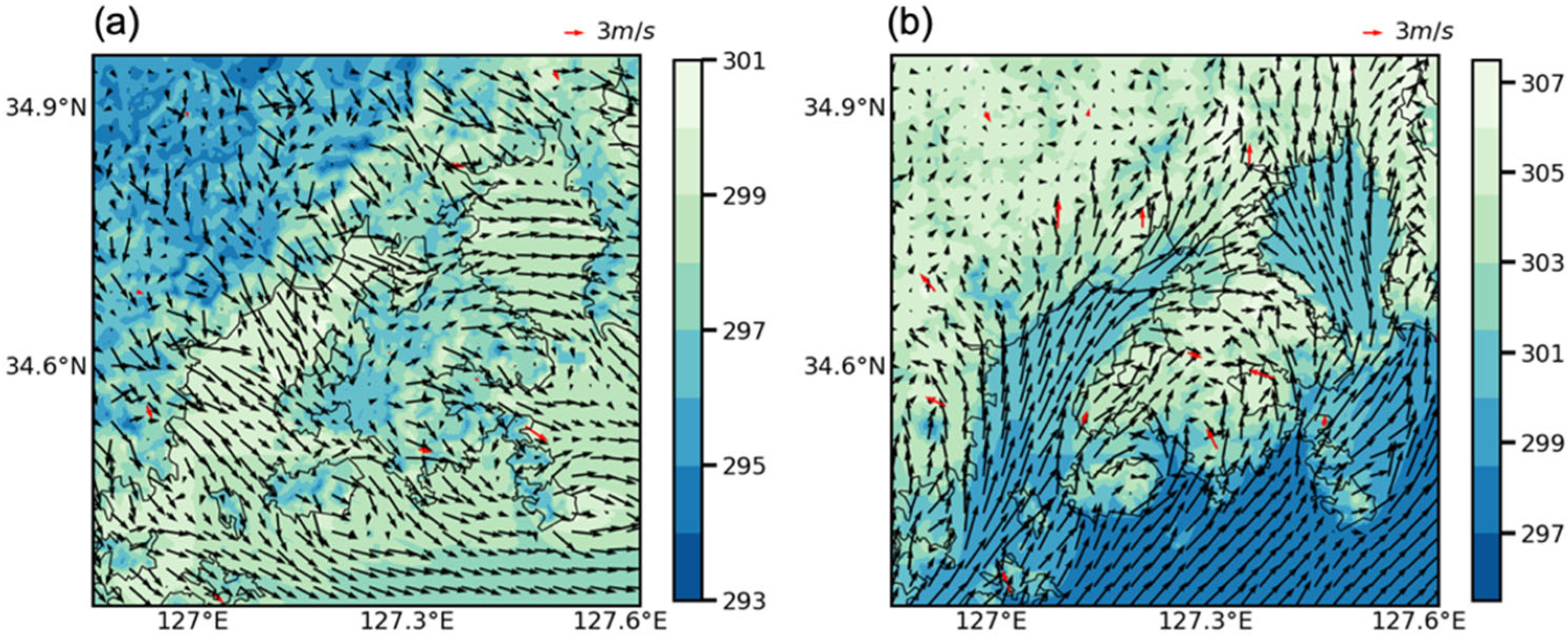
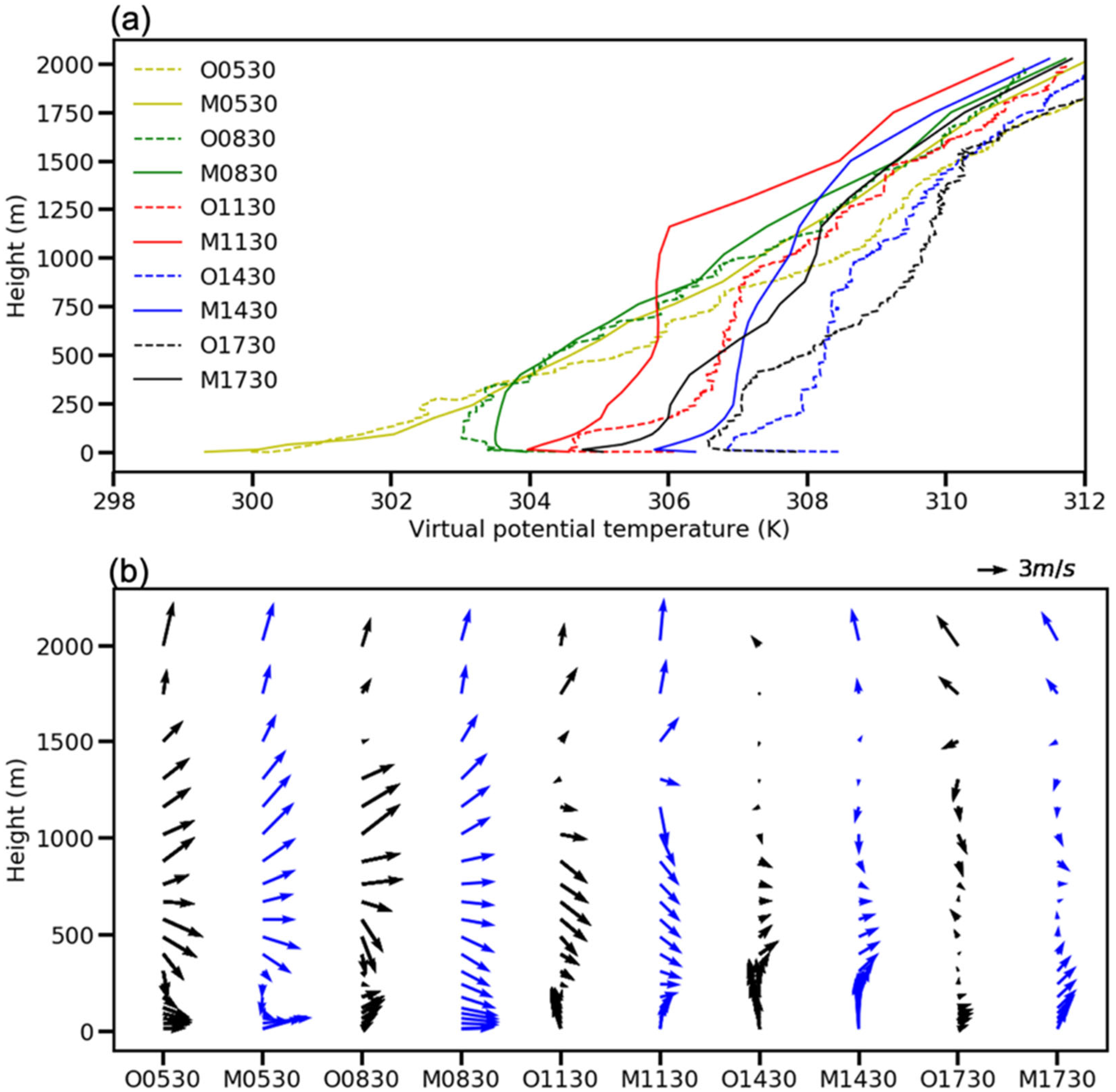
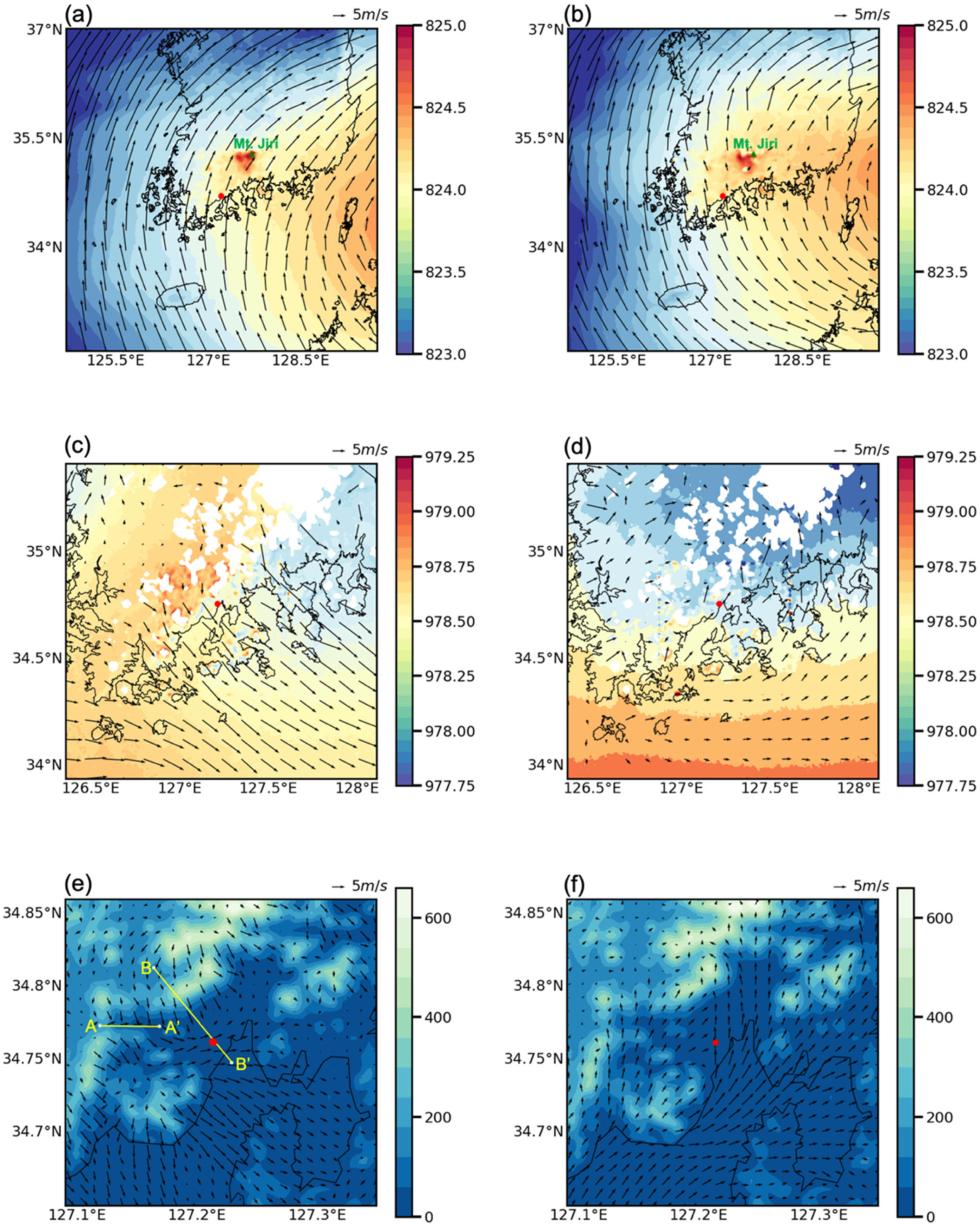
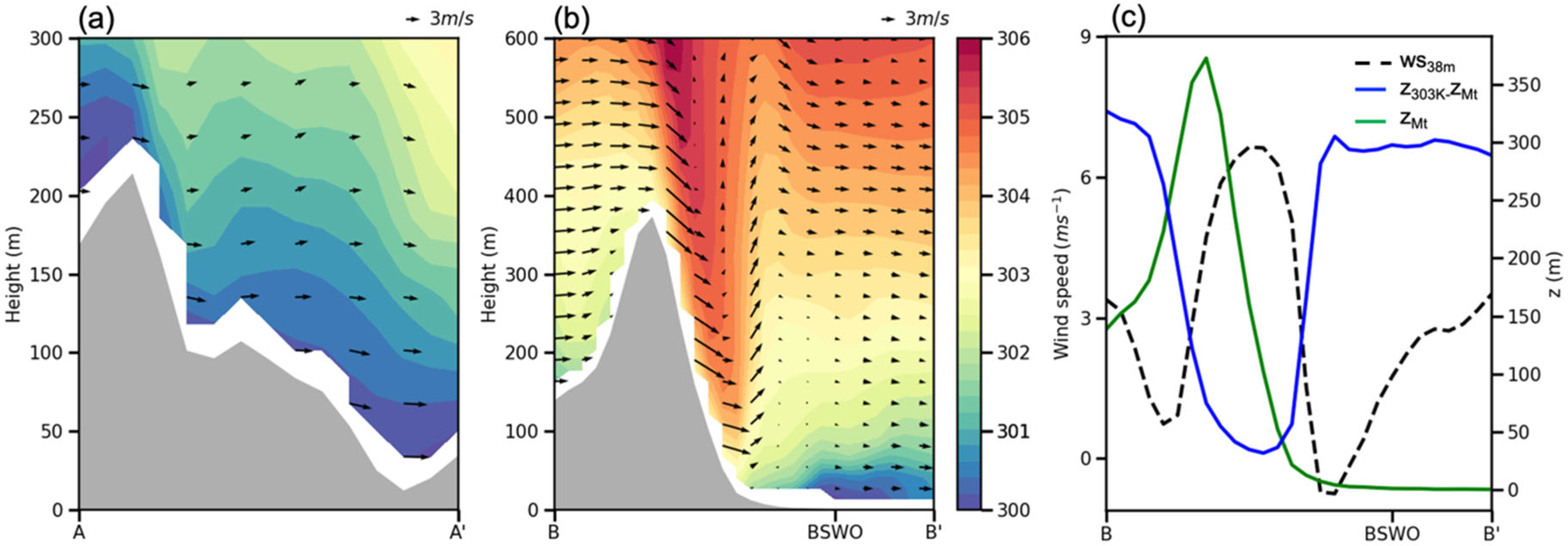
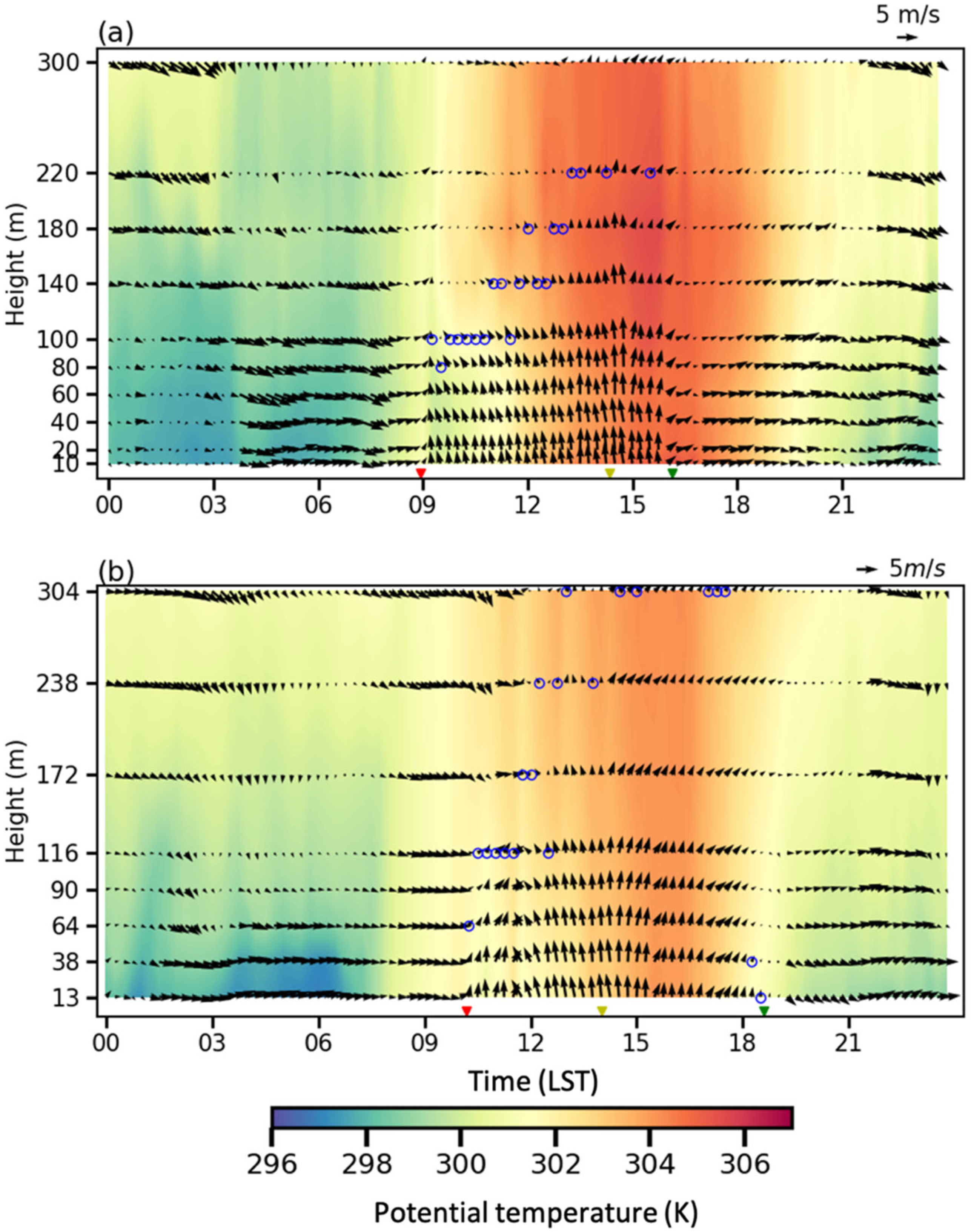

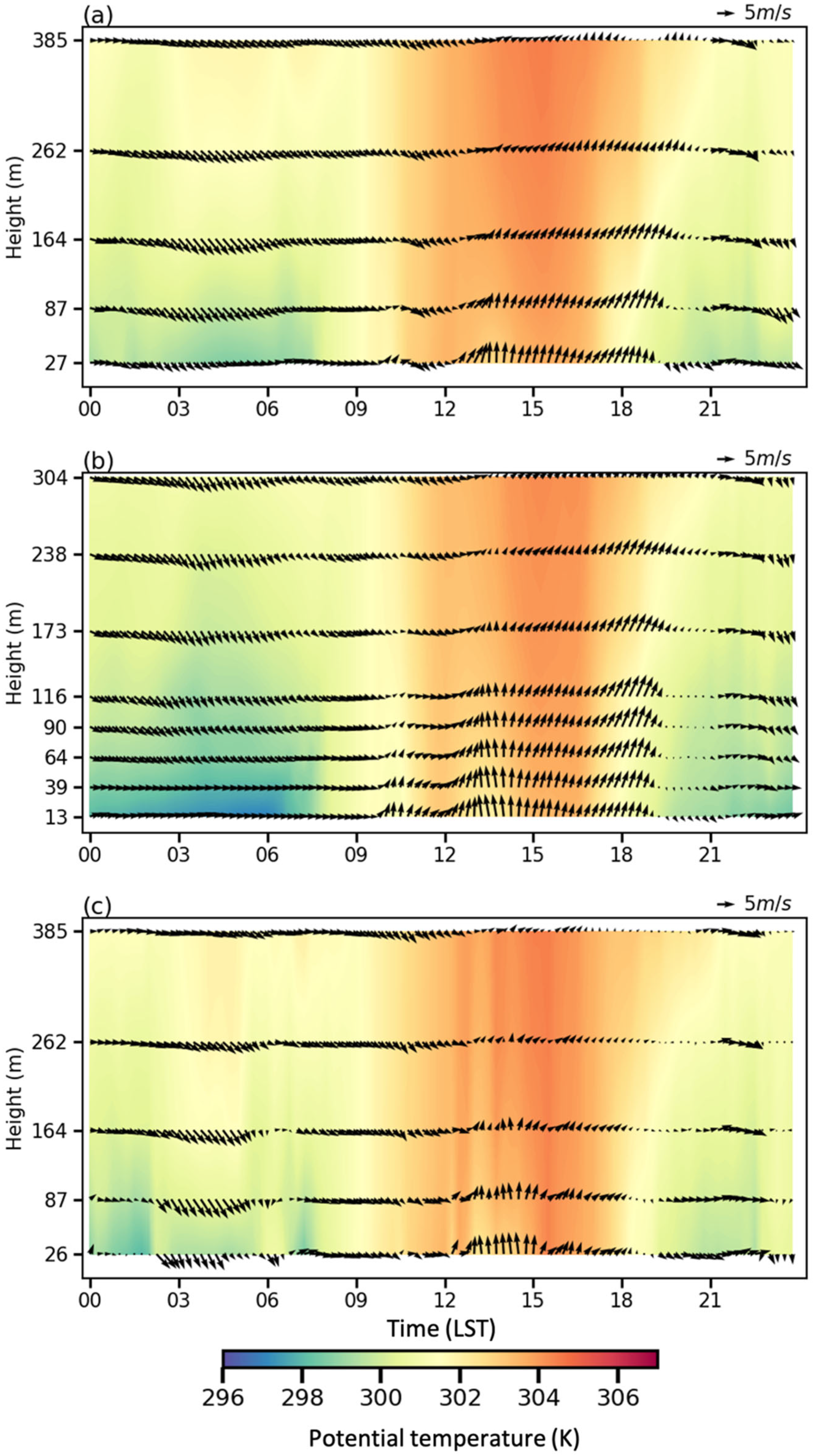
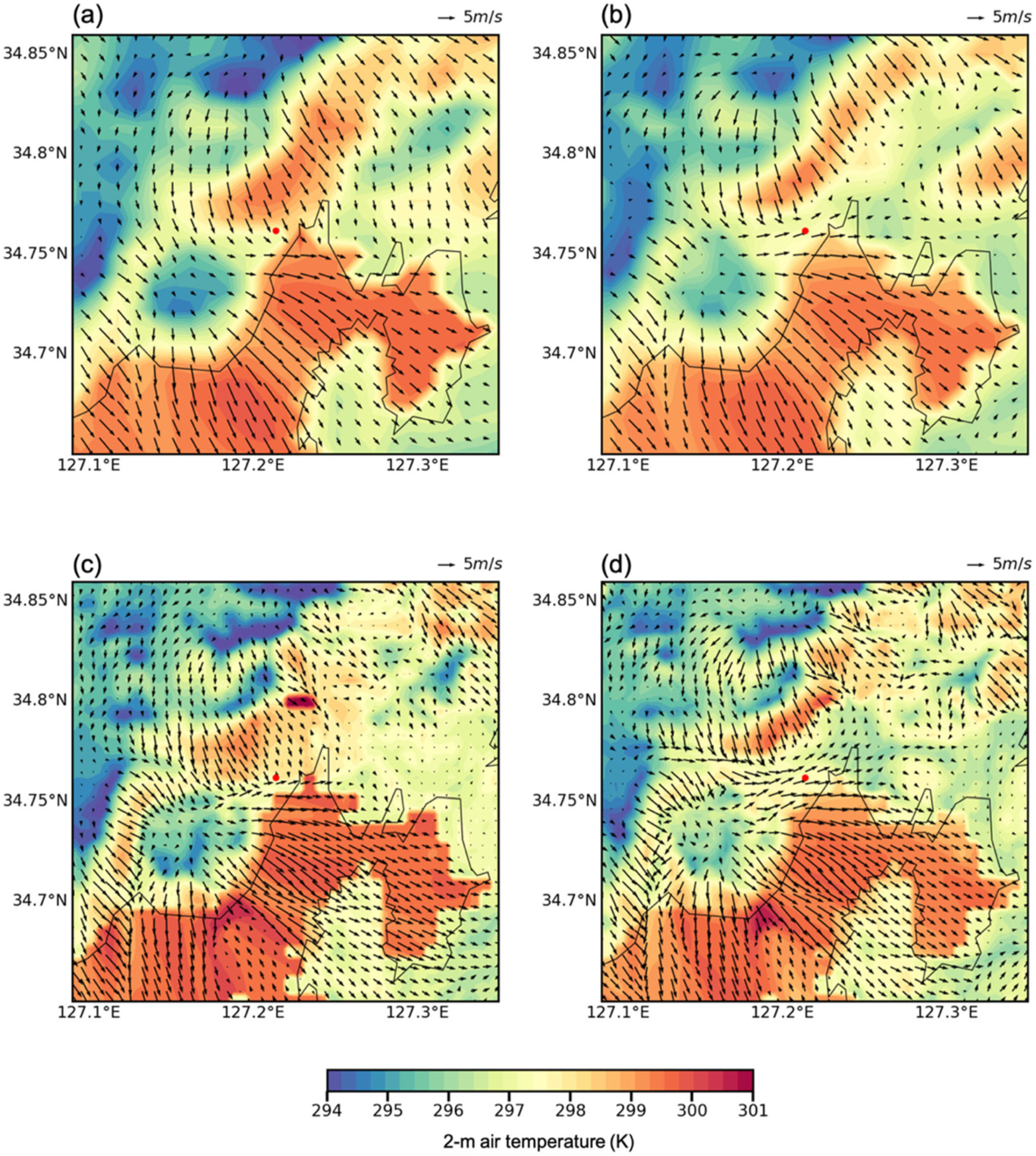
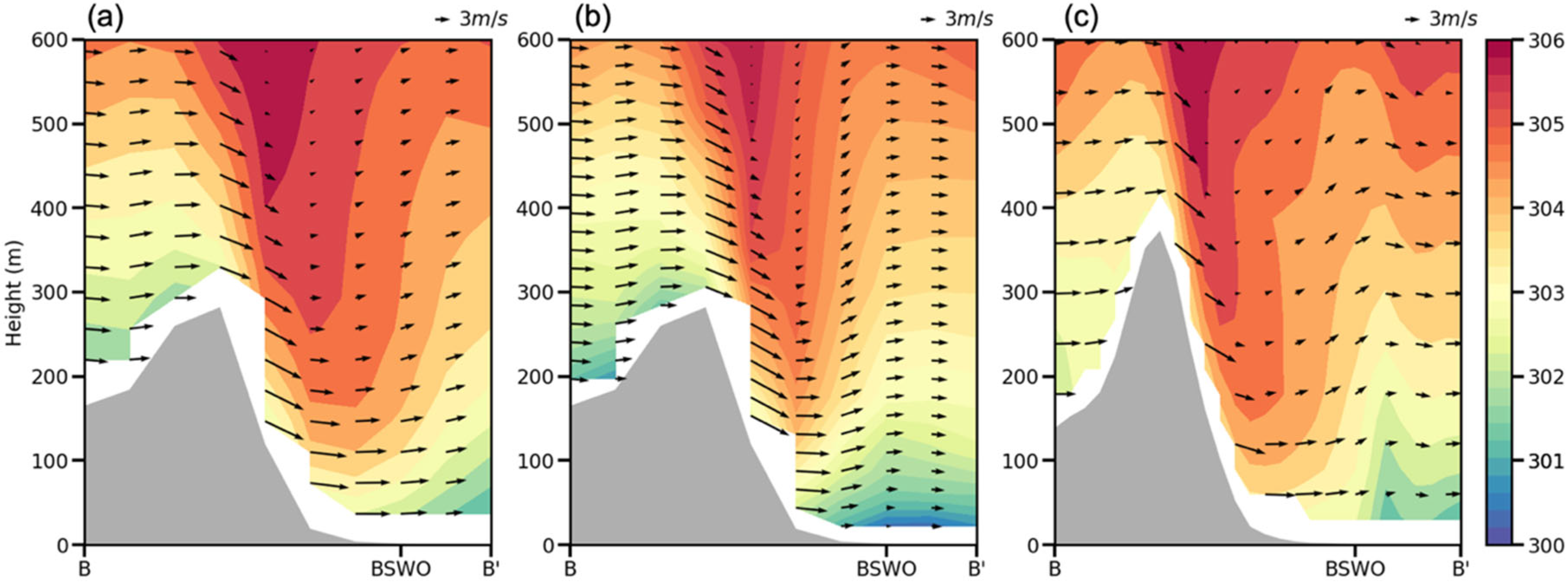
| Domains | D01 | D02 | D03 | D04 |
|---|---|---|---|---|
| Horizontal resolution (m) | 9000 | 3000 | 1000 | 333 |
| Horizontal grid | 181 × 181 | 163 × 163 | 163 × 163 | 210 × 210 |
| Microphysics | WRF double-moment 6-class scheme | |||
| Surface layer | Revised MM5 Monin–Obukhov scheme | |||
| Land surface | Unified Noah land surface model | |||
| Longwave radiation | Rapid radiative transfer model scheme | |||
| Shortwave radiation | Dudhia scheme | |||
| Boundary layer | Shin–Hong scale-aware PBL scheme | |||
| Cumulus | Multiscale Kain–Fritsch scheme | - | - | - |
| Experiment | Horizontal Resolution (m) | Vertical Resolution (Levels) |
|---|---|---|
| S03 | 1000 | 60 |
| S03V | 1000 | 68 |
| S04 | 333 | 60 |
| S04V (Default) | 333 | 68 |
| N | 2-m Air Temperature | 10-m Wind Speed | 10-m Wind Vector | |||||
|---|---|---|---|---|---|---|---|---|
| MBE (K) | RMSE (K) | IOA | MBE (m s−1) | RMSE (m s−1) | IOA | RMSEu,v (m s−1) | IOAu,v | |
| 360 | −0.43 | 1.28 | 0.95 | 0.91 | 1.56 | 0.62 | 2.22 | 0.71 |
| Time (LST) | N | Virtual Potential Temperature | Wind Speed | Wind Vector | |||||
|---|---|---|---|---|---|---|---|---|---|
| MBE (K) | RMSE (K) | IOA | MBE (m s−1) | RMSE (m s−1) | IOA | RMSEu,v (m s−1) | IOAu,v | ||
| 0530 | 20 | −0.34 | 0.65 | 0.99 | 0.39 | 1.16 | 0.51 | 1.51 | 0.86 |
| 0830 | 20 | −0.04 | 0.36 | 0.99 | 1.03 | 1.68 | 0.42 | 2.29 | 0.62 |
| 1130 | 20 | −1.08 | 1.22 | 0.85 | 0.54 | 0.92 | 0.74 | 1.55 | 0.91 |
| 1430 | 20 | −1.13 | 1.18 | 0.74 | 0.41 | 0.97 | 0.89 | 1.3 | 0.92 |
| 1730 | 20 | −1.29 | 1.36 | 0.81 | 0.82 | 1.55 | 0.20 | 1.95 | 0.73 |
| Variables | S04V | S04 | S03V | S03 |
|---|---|---|---|---|
| Onset (LST) | 1011 | 1207 | 0951 | 1257 |
| Cessation (LST) | 1836 | 1707 | 1902 | 1912 |
Publisher’s Note: MDPI stays neutral with regard to jurisdictional claims in published maps and institutional affiliations. |
© 2021 by the authors. Licensee MDPI, Basel, Switzerland. This article is an open access article distributed under the terms and conditions of the Creative Commons Attribution (CC BY) license (https://creativecommons.org/licenses/by/4.0/).
Share and Cite
Lim, H.-J.; Lee, Y.-H. High-Resolution Modeling of Mesoscale Circulation in the Atmospheric Boundary Layer over a Complex Coastal Area. Atmosphere 2021, 12, 1649. https://doi.org/10.3390/atmos12121649
Lim H-J, Lee Y-H. High-Resolution Modeling of Mesoscale Circulation in the Atmospheric Boundary Layer over a Complex Coastal Area. Atmosphere. 2021; 12(12):1649. https://doi.org/10.3390/atmos12121649
Chicago/Turabian StyleLim, Hee-Jeong, and Young-Hee Lee. 2021. "High-Resolution Modeling of Mesoscale Circulation in the Atmospheric Boundary Layer over a Complex Coastal Area" Atmosphere 12, no. 12: 1649. https://doi.org/10.3390/atmos12121649
APA StyleLim, H.-J., & Lee, Y.-H. (2021). High-Resolution Modeling of Mesoscale Circulation in the Atmospheric Boundary Layer over a Complex Coastal Area. Atmosphere, 12(12), 1649. https://doi.org/10.3390/atmos12121649







